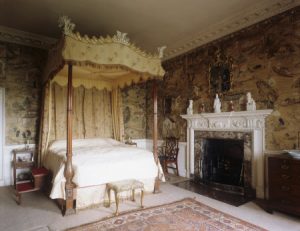Research project Global connections and local contexts: the material culture of Saltram, c. 1725-1840
In 2022 I began researching the material culture of Saltram, a country house in Devon, England, as a Collaborative Doctoral Award research project with the National Trust and Manchester Metropolitan University, funded by the Arts and Humanities Research Council.
Saltram was the country seat of the Parker family for over 200 years and is now in the care of the National Trust. Three generations of the family commissioned and collected thousands of objects between 1725 and 1840 and so, like many country houses, Saltram became a repository for a mix of British, European, and Asian objects. My research is aiming to find out the origin of goods within the collection and the routes of supply through which they came to Saltram. Using existing scholarship and archive material I’ll be exploring the ways in which goods were obtained: through global trade, from Europe or locally through shops, sale rooms, dealers, family connections and direct commissions. Despite the Parker family having no obvious connection to the East India Company, Saltram has four different mid-18th century Chinese wallpapers, as well as a number of Chinese mirror paintings and ceramics. I’ll also be looking at the significance of Plymouth as a port and route for the supply of goods from global trade as well as a hub of local suppliers.

The Chinese Chippendale Bedroom at Saltram. Chippendale possibly supplied the splendid mahogany bed about 1760.
Saltram is well-known within the existing country house historiography as its collections are of national, and in some cases international, significance. However, with the exception of a few direct commissions from the likes of Robert Adam, Angelica Kauffman and Sir Joshua Reynolds, there has been little research undertaken into how objects were acquired and how they were displayed or used by different generations of the family. I’ll be considering what the material and behavioural contexts were in which these things were displayed, used and consumed.
There is a wealth of archive material available on Saltram, which includes family correspondence, account books and inventories. This project will investigate this primary source material critically to map and gather evidence of where the objects came from, where they were displayed or used and motivations for collecting them. Personal taste, as well as changing fashions, will have affected what was purchased. How were individual and assemblages of objects linked to personal identity and how did they reflect and shape the character of the house?
One of the core aims of the project is to work with the team at Saltram to embed this research into interpretation and public programming in the future, helping visitors to understand both the global connections and the local contexts. How can these tangled histories be related to visitors to include and engage local and diverse audiences? If ENCOUNTER members have examples of how these tangled histories have been successfully interpreted, I would be interested to hear from you.
Paula Martin, PhD Researcher (History), Manchester Metropolitan University
contact: paula.martin@stu.mmu.ac.uk

